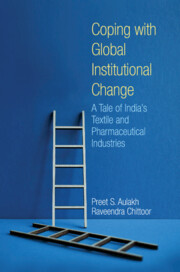Book contents
- Frontmatter
- Dedication
- Contents
- List of Figures
- List of Tables
- List of Appendices
- Preface
- 1 Introduction: The Challenge of Global Institutional Change
- 2 Conceptual Foundations and an Organising Framework
- 3 National Policy Choices
- 4 Industry Evolution: Tale of Two Industries
- 5 Strategic Renewal and Firm-Level Responses
- 6 Conclusion: Implications for Theory and Policy
- Bibliography
- Index
6 - Conclusion: Implications for Theory and Policy
Published online by Cambridge University Press: 11 June 2022
- Frontmatter
- Dedication
- Contents
- List of Figures
- List of Tables
- List of Appendices
- Preface
- 1 Introduction: The Challenge of Global Institutional Change
- 2 Conceptual Foundations and an Organising Framework
- 3 National Policy Choices
- 4 Industry Evolution: Tale of Two Industries
- 5 Strategic Renewal and Firm-Level Responses
- 6 Conclusion: Implications for Theory and Policy
- Bibliography
- Index
Summary
The Indian textile industry … is the 2nd largest manufacturer and exporter in the world, … contributes 7% of industry output in value terms, 2% of India's GDP and 12% of India's export earnings. The textile industry is one of the largest sources of employment generation in the country with 45 million people employed directly…. The sector has perfect alignment with Government's key initiatives….
—Government of India, Ministry of Textiles (2019–2020: 1)The Indian pharmaceutical industry is the world's third largest by volume and 14th largest in terms of value. India has the second-highest number of US FDA approved plants outside the US … [and] is the largest provider of generic drugs globally…. Because of the low price and high quality, Indian medicines are preferred worldwide, thereby rightly making the country the “Pharmacy of the World”. Pharma sector … contributes to around 1.72% of the country's GDP.
—Government of India, Ministry of Chemicals and Fertilizers, Department of Pharmaceuticals (2020–2021: 3)The global institutional changes implemented under the auspices of the World Trade Organization (WTO) in 2005 were expected to challenge the existing sources of competitive advantage in the Indian pharmaceutical and textile industries and thus India's trade position in international markets. These challenges acquired strategic significance at the national level given the historical importance of the two industries to India's attainment of various socio-economic objectives. The above-quoted extracts from the annual reports of the respective ministries of the Government of India fifteen years later suggest that each industry adequately adapted to the global institutional change and was able to maintain or increase its share in global trade, while fulfilling the social goals, that is, employment generation in the textile industry and supply of affordable drugs in the pharmaceutical industry. How were these two industries able to adapt to and cope with externally imposed changes that amounted to tectonic shifts in the rules of the game? Studying similarities and differences in the strategic trajectories of these two very different industries in response to global changes was the primary objective of the current book.
The main argument of this book is that coping with such momentous changes triggered at the global level required a multi-level strategic response. Global institutional change necessitated the search for new organisational capabilities by Indian firms to catch up with global competitors and successfully compete in international markets.
- Type
- Chapter
- Information
- Coping with Global Institutional ChangeA Tale of India's Textile and Pharmaceutical Industries, pp. 162 - 189Publisher: Cambridge University PressPrint publication year: 2022

